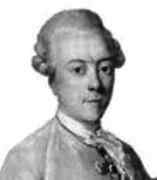Person: Bézout, Étienne

Étienne Bézout was a French mathematician who is best known for his theorem on the number of solutions of polynomial equations.
Mathematical Profile (Excerpt):
- However the remarkable mathematics of Leonard Euler proved stronger than his parents wishes, for once Bézout had read Euler's works he wished to devote himself to mathematics.
- In 1758 Bézout was appointed an adjoint in mechanics of the Académie des Sciences and, in the same year, as royal censor.
- Bézout is famed for the texbooks which came out of this assignment.
- Bézout was appointed to succeed him becoming examiner of the Corps d'Artillerie.
- As might be expected given this approach aimong at the readership for whom Bézout intended his texts, his books came in for a certain amount of criticism for lacking rigour.
- Returning to give more information about Bézout's career, we should note that he was promoted to associé in mechanics at the Académie des Sciences in 1768 and then further promoted to pensionnaire in 1770.
- As we have indicated Bézout is famed for being a writer of textbooks but he is famed also for his work on algebra, in particular on equations.
- The way Bézout went about his research is interesting since still today it is a good approach for obtaining results.
- Bézout had a name for this approach to mathematics, namely the "method of simplifying assumptions".
- Of course on the face of it this does not help solve the equation but Bézout made the simplifying assumption that one of the two equations was of a particularly simple form.
- Already this paper had introduced the topic to which Bézout would make his most important contributions, namely methods of elimination to produce from a set of simultaneous equations, a single resultant equation in one of the unknowns.
- As a result of the ideas in this paper for solving systems of simultaneous equations, Sylvester, in 1853, called the determinant of the matrix of coefficients of the equations the Bézoutiant.
- These and further papers published by Bézout in the theory of equations were gathered together in "Théorie générale des équations algébraiques" Ⓣ(General theory of algebraic equations) which was published in 1779.
- By a complete equation Bézout meant one defined by a polynomial which contains terms of all possible products of the unknowns whose degree does not exceed that of the polynomial.
- Despite this Bézout, who was prepared to enter long and difficult algebraic manipulations, proved his theorem with just a little hand waving over an inductive argument.
- In this work Bézout also gave the first satisfactory proof of a result of Maclaurin on the intersection of two algebraic curves.
Born 31 March 1730, Nemours, France. Died 27 September 1783, Basses-Loges (near Fontainbleau), France.
View full biography at MacTutor
Tags relevant for this person:
Algebra
Thank you to the contributors under CC BY-SA 4.0! 

- Github:
-

- non-Github:
- @J-J-O'Connor
- @E-F-Robertson
References
Adapted from other CC BY-SA 4.0 Sources:
- O’Connor, John J; Robertson, Edmund F: MacTutor History of Mathematics Archive
